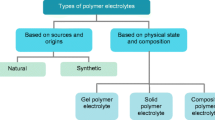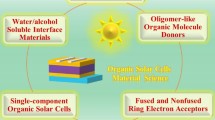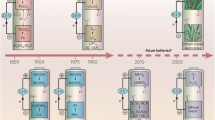Abstract
Electrochromic devices (ECDs) using various polymer electrolyte membranes were evaluated in relation to their optical and electrochemical properties. It was found that the composition of polymer matrix markedly influence the transmittance change (ΔT) and stability of ECDs. The electrochromic (WO3) and ion storage (Antimony tin oxide; ATO) layers were fabricated using dry deposition method. Moreover, various types of polymer matrix were used as the electrolyte, i.e., Liquid; PVdF-HFP (UV-0); PEGDMA-PEGMA/PVdF-HFP blended (UV-30); and PEGDMA-PEGMA solid (UV-100) membranes. ECDs using UV-30 exhibited good cyclability, in which the ΔT of 35% was maintained over 200 cycles. Furthermore, as a result of electrochemical analysis, ECD using UV-30 showed charge density of 34.43 mC/cm2 with low charge transfer resistance of 237.7 Ω at the interface between the coloration layer and electrolyte. Therefore, the solid polymer matrix electrolyte (UV-30) improved the electrochromic performance including stability due to excellent ion dissociation and ion mobility in the electrolyte.










Similar content being viewed by others
References
Somani, P. R., & Radhakrishnan, S. (2003). Electrochromic materials and devices: Present and future. Materials Chemistry and Physics, 77(1), 117–133. https://doi.org/10.1016/S0254-0584(01)00575-2.
Livage, J., & Ganguli, D. (2001). Sol–gel electrochromic coatings and devices: A review. Solar Energy Materials and Solar Cells, 68(3), 365–381. https://doi.org/10.1016/S0927-0248(00)00369-X.
Meda, L., Breitkopf, R. C., Haas, T. E., & Kirss, R. U. (2002). Investigation of electrochromic properties of nanocrystalline tungsten oxide thin film. Thin Solid Films, 402(1), 126–130. https://doi.org/10.1016/S0040-6090(01)01598-X.
Subrahmanyam, A., & Karuppasamy, A. (2007). Optical and electrochromic properties of oxygen sputtered tungsten oxide (WO3) thin films. Solar Energy Materials and Solar Cells, 91(4), 266–274. https://doi.org/10.1016/j.solmat.2006.09.005.
Granqvist, C. G. (2014). Electrochromics for smart windows: Oxide-based thin films and devices. Thin Solid Films, 564, 1–38. https://doi.org/10.1016/j.tsf.2014.02.002.
Roh, G.-Y., Sung, H.-S., Lee, Y.-C., & Lee, S.-E. (2018). Study on optical characteristics of nano hollow silica with TiO2 shell formation. Journal of the Korean Ceramic Society, 56(1), 98–103. https://doi.org/10.4191/kcers.2019.56.1.10.
Zhang, F.-J., Kong, C., Li, X., Sun, X.-Y., Xie, W.-J., & Oh, W.-C. (2019). Synthesis and characterization of MoS2/graphene-TiO2 ternary photocatalysts for high-efficiency hydrogen production under visible light. Journal of the Korean Ceramic Society, 56(3), 284–290. https://doi.org/10.4191/kcers.2019.56.3.06.
Zhang, J., Tu, J. P., Cai, G. F., Du, G. H., Wang, X. L., & Liu, P. C. (2013). Enhanced electrochromic performance of highly ordered, macroporous WO3 arrays electrodeposited using polystyrene colloidal crystals as template. Electrochimica Acta, 99, 1–8. https://doi.org/10.1016/j.electacta.2013.03.099.
Lee, S. H., Deshpande, R., Parilla, P. A., Jones, K. M., To, B., Mahan, A. H., et al. (2006). Crystalline WO3 nanoparticles for highly improved electrochromic applications. Advanced Materials, 18(6), 763–766. https://doi.org/10.1002/adma.200501953.
Shim, H.-S., Kim, J. W., Sung, Y.-E., & Kim, W. B. (2009). Electrochromic properties of tungsten oxide nanowires fabricated by electrospinning method. Solar Energy Materials and Solar Cells, 93(12), 2062–2068. https://doi.org/10.1016/j.solmat.2009.02.008.
Park, S. Y., Lee, J. M., Noh, C., & Son, S. U. (2009). Colloidal approach for tungsten oxide nanorod-based electrochromic systems with highly improved response times and color efficiencies. Journal of Materials Chemistry, 19(42), 7959–7964. https://doi.org/10.1039/B912430F.
Cai, G. F., Tu, J. P., Zhou, D., Wang, X. L., & Gu, C. D. (2014). Growth of vertically aligned hierarchical WO3 nano-architecture arrays on transparent conducting substrates with outstanding electrochromic performance. Solar Energy Materials and Solar Cells, 124, 103–110. https://doi.org/10.1016/j.solmat.2014.01.042.
Liang, L., Zhang, J., Zhou, Y., Xie, J., Zhang, X., Guan, M., et al. (2013). High-performance flexible electrochromic device based on facile semiconductor-to-metal transition realized by WO(3)·2H(2)O ultrathin nanosheets. Scientific Reports, 3, 1936. https://doi.org/10.1038/srep01936.
Cai, G., Cui, M., Kumar, V., Darmawan, P., Wang, J., Wang, X., et al. (2016). Ultra-large optical modulation of electrochromic porous WO3 film and the local monitoring of redox activity. Chemical Science, 7(2), 1373–1382. https://doi.org/10.1039/C5SC03727A.
Zhong, C., Deng, Y., Hu, W., Qiao, J., Zhang, L., & Zhang, J. (2015). A review of electrolyte materials and compositions for electrochemical supercapacitors. Chemical Society Reviews, 44(21), 7484–7539. https://doi.org/10.1039/C5CS00303B.
Thakur, V. K., Ding, G., Ma, J., Lee, P. S., & Lu, X. (2012). Hybrid materials and polymer electrolytes for electrochromic device applications. Advanced Materials, 24(30), 4071–4096. https://doi.org/10.1002/adma.201200213.
Kumar, P., Singh, A. D., Kumar, V., & Kundu, P. P. (2015). Incorporation of nano-Al2O3 within the blend of sulfonated-PVdF-co-HFP and Nafion for high temperature application in DMFCs. RSC Advances, 5(78), 63465–63472. https://doi.org/10.1039/C5RA07992F.
Wu, C.-G., Lu, M.-I., Tsai, C.-C., & Chuang, H.-J. (2006). PVdF-HFP/metal oxide nanocomposites: the matrices for high-conducting, low-leakage porous polymer electrolytes. Journal of Power Sources, 159(1), 295–300. https://doi.org/10.1016/j.jpowsour.2006.04.108.
Wu, C.-G., Lu, M.-I., & Chuang, H.-J. (2005). PVdF-HFP/P123 hybrid with mesopores: a new matrix for high-conducting, low-leakage porous polymer electrolyte. Polymer, 46(16), 5929–5938. https://doi.org/10.1016/j.polymer.2005.05.077.
Ulaganathan, M., Mathew, C. M., & Rajendran, S. (2013). Highly porous lithium-ion conducting solvent-free poly(vinylidene fluoride-co-hexafluoropropylene)/poly(ethyl methacrylate) based polymer blend electrolytes for Li battery applications. Electrochimica Acta, 93, 230–235. https://doi.org/10.1016/j.electacta.2013.01.100.
Song, J. Y., Wang, Y. Y., & Wan, C. C. (2000). Conductivity study of porous plasticized polymer electrolytes based on poly(vinylidene fluoride) A comparison with polypropylene separators. Journal of The Electrochemical Society, 147(9), 3219–3225. https://doi.org/10.1149/1.1393886.
Li, G. C., Zhang, P., Zhang, H. P., Yang, L. C., & Wu, Y. P. (2008). A porous polymer electrolyte based on P(VDF-HFP) prepared by a simple phase separation process. Electrochemistry Communications, 10(12), 1883–1885. https://doi.org/10.1016/j.elecom.2008.09.035.
Zhu, Y., Yang, Y., Fu, L., & Wu, Y. (2017). A porous gel-type composite membrane reinforced by nonwoven: promising polymer electrolyte with high performance for sodium ion batteries. Electrochimica Acta, 224, 405–411. https://doi.org/10.1016/j.electacta.2016.12.030.
Cao, J.-H., Zhu, B.-K., & Xu, Y.-Y. (2006). Structure and ionic conductivity of porous polymer electrolytes based on PVDF-HFP copolymer membranes. Journal of Membrane Science, 281(1), 446–453. https://doi.org/10.1016/j.memsci.2006.04.013.
Ghosh, A., Wang, C., & Kofinas, P. (2010). Block copolymer solid battery electrolyte with high Li–Ion transference number. Journal of the Electrochemical Society, 157(7), A846–A849. https://doi.org/10.1149/1.3428710.
Cheng, C. L., Wan, C. C., & Wang, Y. Y. (2004). Microporous PVdF-HFP based gel polymer electrolytes reinforced by PEGDMA network. Electrochemistry Communications, 6(6), 531–535. https://doi.org/10.1016/j.elecom.2004.04.001.
Lin, S.-Y., Chen, Y.-C., Wang, C.-M., Wen, C.-Y., & Shih, T.-Y. (2012). Study of MoO3–NiO complementary electrochromic devices using a gel polymer electrolyte. Solid State Ionics, 212, 81–87. https://doi.org/10.1016/j.ssi.2012.02.005.
Sim, L. N., Majid, S. R., & Arof, A. K. (2012). Characteristics of PEMA/PVdF-HFP blend polymeric gel films incorporated with lithium triflate salt in electrochromic device. Solid State Ionics, 209–210, 15–23. https://doi.org/10.1016/j.ssi.2011.11.035.
Ding, Y., Zhang, P., Long, Z., Jiang, Y., Xu, F., & Di, W. (2009). The ionic conductivity and mechanical property of electrospun P(VdF-HFP)/PMMA membranes for lithium ion batteries. Journal of Membrane Science, 329(1), 56–59. https://doi.org/10.1016/j.memsci.2008.12.024.
Gebreyesus, M. A., Purushotham, Y., & Kumar, J. S. (2016). Preparation and characterization of lithium ion conducting polymer electrolytes based on a blend of poly(vinylidene fluoride-co-hexafluoropropylene) and poly(methyl methacrylate). Heliyon, 2(7), e00134. https://doi.org/10.1016/j.heliyon.2016.e00134.
Saito, Y., Kataoka, H., Capiglia, C., & Yamamoto, H. (2000). Ionic conduction properties of PVDF−HFP type gel polymer electrolytes with lithium imide salts. The Journal of Physical Chemistry B, 104(9), 2189–2192. https://doi.org/10.1021/jp993723h.
Bella, F., Pugliese, D., Nair, J. R., Sacco, A., Bianco, S., Gerbaldi, C., et al. (2013). A UV-crosslinked polymer electrolyte membrane for quasi-solid dye-sensitized solar cells with excellent efficiency and durability. Physical Chemistry Chemical Physics, 15(11), 3706–3711. https://doi.org/10.1039/C3CP00059A.
McBreen, J., Lee, H., Yang, X., & Sun, X. (1999). New polymer and liquid electrolytes for lithium batteries. Upton: Brookhaven National Lab.
Yang, C.-M., Ju, J. B., Lee, J. K., Cho, W. I., & Cho, B. W. (2005). Electrochemical performances of electric double layer capacitor with UV-cured gel polymer electrolyte based on poly[(ethylene glycol)diacrylate]–poly(vinylidene fluoride) blend. Electrochimica Acta, 50(9), 1813–1819. https://doi.org/10.1016/j.electacta.2004.08.033.
Reiter, J., Krejza, O., & Sedlaříková, M. (2009). Electrochromic devices employing methacrylate-based polymer electrolytes. Solar Energy Materials and Solar Cells, 93(2), 249–255. https://doi.org/10.1016/j.solmat.2008.10.010.
Roerdink, E., & Challa, G. (1978). Influence of tacticity of poly(methyl methacrylate) on the compatibility with poly(vinylidene fluoride). Polymer, 19(2), 173–178. https://doi.org/10.1016/0032-3861(78)90034-4.
Kim, H., Park, Y., Choi, D., Ahn, S.-H., & Lee, C. S. (2016). Novel fabrication of an electrochromic antimony-doped tin oxide film using a nanoparticle deposition system. Applied Surface Science, 377, 370–375. https://doi.org/10.1016/j.apsusc.2016.03.170.
Park, S.-I., Quan, Y.-J., Kim, S.-H., Kim, H., Kim, S., Chun, D.-M., et al. (2016). A review on fabrication processes for electrochromic devices. International Journal of Precision Engineering and Manufacturing-Green Technology, 3(4), 397–421. https://doi.org/10.1007/s40684-016-0049-8.
Choi, D., Lee, M., Kim, H., Chu, W.-S., Chun, D.-M., Ahn, S.-H., et al. (2017). Fabrication of transparent conductive tri-composite film for electrochromic application. Applied Surface Science, 425, 1006–1013. https://doi.org/10.1016/j.apsusc.2017.07.076.
Soboleva, T., Xie, Z., Shi, Z., Tsang, E., Navessin, T., & Holdcroft, S. (2008). Investigation of the through-plane impedance technique for evaluation of anisotropy of proton conducting polymer membranes. Journal of Electroanalytical Chemistry, 622(2), 145–152. https://doi.org/10.1016/j.jelechem.2008.05.017.
Saikia, D., & Kumar, A. (2004). Ionic conduction in P(VDF-HFP)/PVDF–(PC + DEC)–LiClO4 polymer gel electrolytes. Electrochimica Acta, 49(16), 2581–2589. https://doi.org/10.1016/j.electacta.2004.01.029.
Zhang, X., Huang, Z., Ma, B., Wen, R., Zhang, M., Huang, Y., et al. (2016). Polyethylene glycol/Cu/SiO2 form stable composite phase change materials: preparation, characterization, and thermal conductivity enhancement. RSC Advances, 6(63), 58740–58748. https://doi.org/10.1039/C6RA12890D.
Leprince, J. G., Palin, W. M., Hadis, M. A., Devaux, J., & Leloup, G. (2013). Progress in dimethacrylate-based dental composite technology and curing efficiency. Dental Materials, 29(2), 139–156. https://doi.org/10.1016/j.dental.2012.11.005.
Yang, M., & Hou, J. (2012). Membranes in lithium ion batteries. Membranes, 2(3), 367.
Saikia, D., Wu, H.-Y., Pan, Y.-C., Lin, C.-P., Huang, K.-P., Chen, K.-N., et al. (2011). Highly conductive and electrochemically stable plasticized blend polymer electrolytes based on PVdF-HFP and triblock copolymer PPG-PEG-PPG diamine for Li–ion batteries. Journal of Power Sources, 196(5), 2826–2834. https://doi.org/10.1016/j.jpowsour.2010.10.096.
Wen, R.-T., Malmgren, S., Granqvist, C. G., & Niklasson, G. A. (2017). Degradation dynamics for electrochromic WO3 films under extended charge insertion and extraction: Unveiling physicochemical mechanisms. ACS Applied Materials and Interfaces, 9(14), 12872–12877. https://doi.org/10.1021/acsami.7b01324.
Choudhury, S., Saha, T., Naskar, K., Stamm, M., Heinrich, G., & Das, A. (2017). A highly stretchable gel-polymer electrolyte for lithium-sulfur batteries. Polymer, 112, 447–456. https://doi.org/10.1016/j.polymer.2017.02.021.
Acknowledgement
This work was supported by the National Research Foundation of Korea (NRF) Grant funded by the Korea government (MSIT) (No. 2019R1F1A1060586) and under the framework of international cooperation program managed by the National Research Foundation of Korea (NRF-2020K2A9A2A06071441, FY2020).
Author information
Authors and Affiliations
Corresponding author
Ethics declarations
Conflicts of interest
The authors declare that there is no conflict of interest regarding the publication of this article.
Additional information
Publisher's Note
Springer Nature remains neutral with regard to jurisdictional claims in published maps and institutional affiliations.
Electronic supplementary material
Below is the link to the electronic supplementary material.
Rights and permissions
About this article
Cite this article
Lee, M., Son, M., Chun, Dm. et al. Evaluation of Electrochromic Device Influenced by Various Formulation of Solid Polymer Electrolyte. Int. J. Precis. Eng. Manuf. 22, 189–199 (2021). https://doi.org/10.1007/s12541-020-00451-4
Received:
Revised:
Accepted:
Published:
Issue Date:
DOI: https://doi.org/10.1007/s12541-020-00451-4




